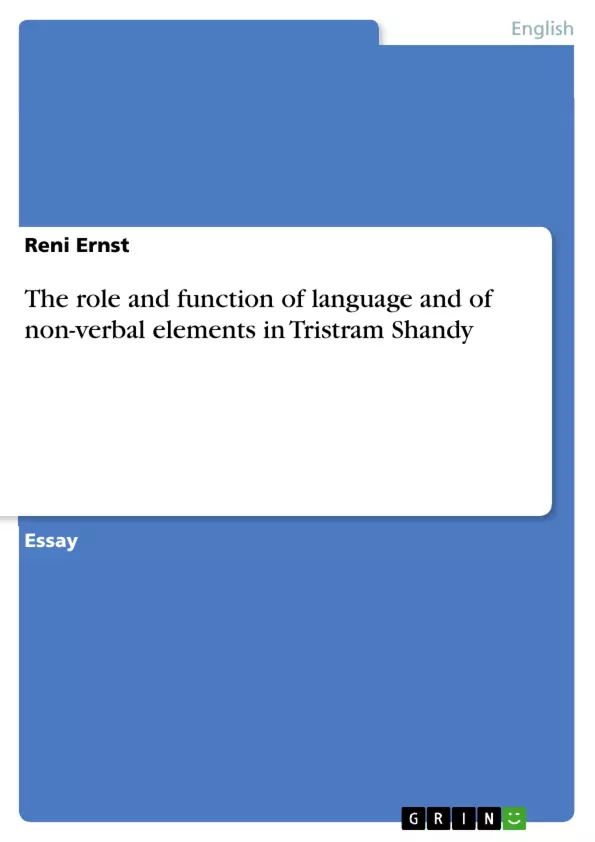The 18th century novel Tristram Shandy written by Laurence Sterne could be described as an anti- novel since it moves away from the conventional realist novel which used to be the only predominant style in novel writing at that time. Sterne rejects the traditional narrative technique of presenting a chronological plot with beginning, middle and end and instead offers the reader a non-chronological story rather built around digressions than following a straight forward narration. In order to reveal the way in which Sterne achieves this contemporary uncommon style one has to take a closer look at the role and function of language and non-verbal elements in Tristram Shandy.
Inhaltsverzeichnis (Table of Contents)
- The role and function of language and of non-verbal elements in Tristram Shandy
- The language Sterne uses resembles real speech
- The inability of expressing oneself through language is also the reason for the appearance of the hobby horses
- Every single word is a matter of interpretation and its meaning dependent on every individuals association
- Although Tristram points out that “Wrtiting, when properly managed, (as you may be sure I think mine is) is but a different name for conversation...\" (2.11.87), the whole novel contains gaps, missing and displaced chapters, a narrative that goes forwards and backwards, black, blank and marbled pages and several asterisks, all of which disrupt the fluency of the story and thus contribute to the failure and disconnection of communication
- In addition Sterne directly points to the reader's imagination when presenting several partly successive words or sentences consisting only of asterisks
- Another non-verbal element Sterne makes use of to modify the effect of speech and language is the dash which occurs principally when a pause in speaking should be expressed
Zielsetzung und Themenschwerpunkte (Objectives and Key Themes)
This paper explores the unique narrative style of Laurence Sterne's Tristram Shandy, arguing that it deviates from the conventional realist novel of the 18th century by employing unconventional linguistic and non-verbal elements. The paper examines how Sterne's use of language, digressions, and non-verbal cues contribute to the novel's unconventional structure and its exploration of the limitations of language.
- The role of language and its limitations in expressing thoughts and experiences
- The use of digressions and non-chronological narration to create a fragmented and subjective narrative
- The importance of non-verbal elements, such as blank pages and asterisks, in engaging the reader's imagination and interpretation
- The relationship between language, thought, and the construction of identity
- The unconventional narrative techniques of Tristram Shandy as a precursor to modernist and postmodernist literature
Zusammenfassung der Kapitel (Chapter Summaries)
The paper analyzes the role of language in Tristram Shandy by examining Sterne's use of colloquialisms, broken sentences, and pauses to convey the imperfections of language. It also explores the limitations of language in representing complex thoughts and experiences, particularly evident in Tristram's struggles with writing his own story and Uncle Toby's difficulty in expressing his experiences of war.
The paper then explores the role of hobby horses as a metaphor for the limitations of communication, highlighting how these obsessions create barriers to understanding and foster isolation. The instability of language and its reliance on individual interpretation is further examined through the example of Uncle Toby's efforts to explain military terms, demonstrating the need for precise definitions and explanations.
The paper delves into the use of non-verbal elements, such as blank pages and asterisks, in disrupting the flow of the narrative and inviting the reader's participation in the construction of meaning. The analysis suggests that these non-verbal elements are not simply decorative but contribute to the novel's overall chaotic style and its exploration of the limitations of language and the importance of imagination.
Schlüsselwörter (Keywords)
This paper delves into the unique narrative style of Tristram Shandy by analyzing the role of language, non-verbal elements, digressions, and the reader's active engagement in constructing meaning. Key terms include: language, non-verbal elements, digressions, fragmented narrative, subjectivity, realism, reader engagement, interpretation, imagination, and 18th-century novel.
- Citation du texte
- Reni Ernst (Auteur), 2005, The role and function of language and of non-verbal elements in Tristram Shandy, Munich, GRIN Verlag, https://www.grin.com/document/80943



